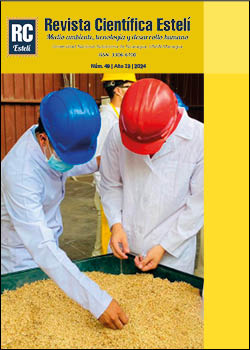Study on equivalence relationships in the different number domains with one and two operations
DOI:
https://doi.org/10.5377/esteli.v13i49.17887Keywords:
Equivalence relations, number domains, structure, operations, propertiesAbstract
This paper deals with the study of equivalence relations in different numerical domains involving one and two operations. It is known that equivalence relations have an essential role in the analysis and study of numerical sets, in turn they allow to establish connections between elements within a given set. The main objective of this study is to provide an in-depth understanding of equivalence relations in the construction of various domains (N←Z←Q←R) and to examine how they influence their structure and properties. This inclusive conjunctive hierarchy shows how numerical sets are constructed in a stepwise manner, extending the properties and characteristics of previous sets. The construction of these domains is fundamental in mathematics and has applications in a variety of fields, from basic arithmetic to advanced mathematical analysis. In addition, the definitions and applications of these equivalence relations will be explored, and the implications they have in the proof of different theorems are investigated. On the other hand, through this analysis, we seek to contribute to the advancement of the theory of numerical sets, providing useful conceptual tools for the study of these domains. It is also expected that this article will provide a solid basis for future research in the field of equivalence relations within the different numerical domains, likewise that the properties of an equivalence relation by means of the union and intersection operations using equivalence relations and transitive envelopes will generate a better understanding of each structure and in general of these fundamental mathematical systems.
Downloads
References
Asghari. (2005). Equivalence: An Attempt at a History of the Idea [Equivalencia: un intento de historia de la idea]. https://doi.org/https://philsci-archive.pitt.edu/14261/1/Equivalence%20An%20Attempt%20at%20a%20History%20of%20the%20Idea.pdf
Asghari, A. H. (2008). Experiencing equivalence but organizing order.
Curveira, D., & Bravo, G. (2013). Tratamiento de Conceptos Matemáticos y su repercusión en el proceso de formación profesional. Universidad y Sociedad, 10.
Gónzalez, F. (2004). Apuntes de Matemática Discreta y Relaciones de Equivalencia. Madrid: Universidad de Cadíz.
Herrera, A., & Cisneros, I. (2023). Itinerario genético de las relaciones de equivalencia en la escuela y la vida diaria. Revista Científica de FAREM - Estelí. Medio Ambiente, tecnología y desarrollo humano(45), 148–170. https://doi.org/https://doi.org/10.5377/farem.v12i45.16042
Joyce, D. (12 de Enero de 1996). Elementod de Euclide. Libro 1. Nociones Comunes. http://ficus.pntic.mec.es/~jgog0066/pitag_web/noccom.html
Kennet, R. (2004). Matmemática Discretas y sus aplicaciones. Madrid: McGRAW-HILL/Interamericana de España S. A. U.
Koulikov. (1982). Algébre et théorie des nombres. Francia: Mir.
Revilla, F. (2010). Cursos Matematicos - Relaciones de Equivalencia. https://doi.org/https://pdfcoffee.com/relaciones-de-equivalencia-4-pdf-free.html
Rojo, A. (1996). Algebra I. Buenos Aires: El Ateneo.
Published
How to Cite
Issue
Section
License
Copyright (c) 2024 Revista Científica Estelí

This work is licensed under a Creative Commons Attribution-NonCommercial-ShareAlike 4.0 International License.

